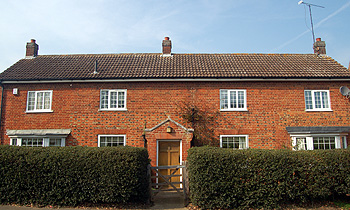The White Horse Public House Woburn

31 Leighton Street, March 2012
The White Horse Public: Leighton End, Woburn
A White Horse is mentioned in the parochial assessment register for Woburn dating between 1802 and 1833 [ref: P118/28/2]. The property is described as in Leighton End. Confirmation of this comes from mention of this White Horse as abutting Corn Close to the South. This White Horse is also described in Thomas Evans' survey of 1821-2 [ref: R2/69].
In 1841 the licensee, Daniel Sharp, gave evidence that a customer, William Williams, made off with a pewter tankard [ref: QSR1841/3/5/18]. Shortly before Williams left Sharp served him with a quart of beer in the pewter quart pot. He did not notice the pot again until it was brought to him by John Sinfield the night watchman. The pot was worth two shillings. John Sinfield was the night watchman of Woburn. Just after midnight he met William Williams in Leighton Street coming from the direction of the White Horse towards his home. Sinfield saw the quart pot in his hands so he stopped Williams and asked him what he had got. Williams foolishly said "one of old Sharp's pots" He asked Williams if Sharp had allowed him to take it away - Sharp had previous told him he had lost several pots and he suspected this one was also stolen. Williams did not reply. There was no more than a quarter of a pint of beer in the pot. Sinfield then took Williams back to the public house carrying the pot and called Sharp, who said it was his pot.
Interestingly Williams stated that he "went to the Club at Sharp's house". He received his ticket for a pint of beer. He said he was taking the pot down to his mother who was sitting up for him. The Bedford Gaol reihster [ref: QGV10/2] reveals that Williams was nineteen. He stood five feet six inches tall, had brown hair and hazel eyes which were "rather sunk". He was convicted and spent onw week in the gaol during which time his conduct was "very good".
The final mentions of the White Horse are in Kelly's Directory for Bedfordshire. Bedfordshire Archives has a gap between 1869 when the public house is mentioned and 1877 when it is not indicating that the inn was probably closed around this date. The building stood a long way out of the centre of Woburn, somewhere in the vicinity of the modern Timber Lane on the north-west side of the road, but exactly where is difficult to say.
The modern numbers 25 to 30 Leighton Street (Duke of Bedford's cottages) have a date of 1851 and so cannot have been built on the site of the public house unless the directory is wrong by at least 18 years, which seems unlikely. The other possibility is that the public house was on the site of the modern number 31 but this looks, from the size and shape of its bricks, to be quite an old building. It is just possible that this is the former public house but without the evidence of deeds that can only be a highly speculative guess.
In 1927 the property was valued under the 1925 Rating and Valuation Act. It was then owned by the Duke of Bedford and occupied by a Mary Morrison. It was described as a detached property built of brick and slate and comprising a hall, three living rooms, a kitchen and scullery downstairs with four bedrooms above and with two cellars under the ground floor. The valuer noted "Rooms small all front" and "Bad slope at back…not much garden"; in that garden were a coal barn and W. C.
List of Licensees: note that this is not a complete list. Italics indicate licensees whose beginning and/or end dates are not known:
1802-1818: John Smith;
1822: Elizabeth Smith;
1822-1828: James Morgan;
1839-1849: Daniel Sharp;
1849-1850: Charlotte Sharp;
1853-1869: Jesse Lewis (also shoemaker)
List of sources at Bedfordshire Archives:
- P118/28/2: Parochial assessment book: 1802-1833
- R6/63/16/36: White Horse mentioned as abutting Corn Close to the south: 1816
- R1/78: Thomas Evans' map accompanying R2/69: 1821
- R2/69: Survey of Woburn made by Thomas Evans for Duke of Bedford: 1822
- QSR1841/3/5/18: Theft from the premises: 1841.